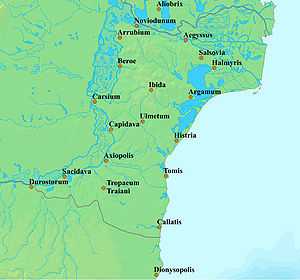Halmyris
| Halmyris | |
|---|---|
 Location within Romania | |
| Alternative name(s) | Salmorus, Thalamonium |
| Founded during the reign of | Trajan |
| Founded | 2nd century AD |
| Abandoned | 7th century AD |
| Previous fortification | Getic |
| Place in the Roman world | |
| Province | Moesia |
| Administrative unit | Scythia Minor |
| Administrative unit | Moesia Inferior |
| Structure | |
| — Stone structure — | |
| — Wood and earth structure — | |
| Built during the reign of | Trajan |
| Stationed military units | |
| — Legions — | |
| |
| — Classis — | |
| Flavia Moesica | |
| Location | |
| Coordinates | 45°01′30″N 29°11′52″E / 45.0249°N 29.1977°ECoordinates: 45°01′30″N 29°11′52″E / 45.0249°N 29.1977°E |
| Altitude | c. 26 m |
| Town | Murighiol |
| County | Tulcea |
| Country |
|
| Site notes | |
| Condition | Ruined |
| Excavation dates | Currently under excavation |
| Archaeologists |
|
| Exhibitions | Muzeul de Istorie şi Arheologie - Tulcea |
| Website | http://www.halmyris.org/ |

Halmyris was a Roman legionary base and naval port for 600 years, located at the mouth of the Danube Delta in Romania.
History
The city (better known by its Greek name) was situated in ancient times on the shore of the Halmyris gulf. It was named Salmorus/Thalamonium in the Roman period, the Latin for Halmyris—salt water.
The region was inhabited during the Second Iron Age; nearby two Getic incineration necropoli were discovered, dating from 4th-2nd centuries BC. In the Roman period, on a 3rd-2nd century BC Getic settlement, the first stone castrum was built during Trajan's reign. The fortification was destroyed several times and had four phases of reconstruction. It was abandoned in the 7th century AD.
The Late Roman fortification had a trapezoid shape, two gates, 15 towers and a defensive system of three vallae and ditches. Inside thermae, a basilica, administrative buildings and dwelling places were discovered.
Halmyris was the most easterly point of the Danubian border in Roman times and probably served as a supply centre for the fleet; early Roman inscriptions inform us of the existence of a "mariner's village"—vicus classicorum. During the late Roman period two units of the military fleet—Classis in Plateypegiis and Musculi Schytici (which had little ships, suited for the Danube Delta) may have been hosted by this city.
As for religious life, we know that in 290 AD, during the persecutions ordered by Diocletian, Saint Epictetus and Astion suffered martyrdom at Halmyris.
- Halmyris served as a depot for supplies, colonization and cultural exchange in the region for 1,100 years. It was occupied from the Iron Age to the Byzantine period.
- The original fort was made of timber and turf, but as the fort gained importance and a regular garrison was established along the Danube, the fort was rebuilt in stone.
- Early in the fort's history, the Goths and Huns from the North crossed the Danube and conquered the fort. It was later re-captured by the Romans.
- In the early 4th century, the Emperor Constantine added a basilica.
- A series of earthquakes altered the course of the Danube and the fort became more removed from the river. Halmyris gradually lost its importance and was abandoned.
Current activities
- The fort is being excavated by Dr. Mihail Zahariade and Dr. John Karavas.
- Current areas of excavation include the military barracks, northwestern towers and harbor installations.
References
- The Archeological Museum, Tulcea, Romania